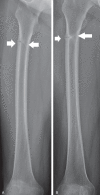Successful conservative treatment: multiple atypical fractures in osteoporotic patients after bisphosphate medication: a unique case report
- PMID: 25654380
- PMCID: PMC4602721
- DOI: 10.1097/MD.0000000000000446
Successful conservative treatment: multiple atypical fractures in osteoporotic patients after bisphosphate medication: a unique case report
Abstract
Bisphosphonates have been commonly used for the treatment of osteoporosis. However, there have been recent case reports of atypical fractures citing their long-term use, which inhibits the turnover of bone components. A 64-year-old woman visited the outpatient clinic with pain in her right thigh and ambulation difficulty. We found fractures at both pedicles of L4 vertebra. subtrochanteric region of right femur, and left femoral shaft upon a radiologic examination. She had taken intravenous ibandronic sodium for osteoporosis over 3 years. We changed the bishophonates to a parathyroid hormone because it was suspected that the multiple fractures were caused by the medication. Further, rehabilitation, including progressive weight bearing, was started. After 3 months of the conservative treatment, she was able to walk independently. In conclusion, it is necessary to evaluate the possibility of atypical fractures in osteoporotic patients when they complain of lower extremity pain and to consider alternative treatments instead of bisphosphonates.
Conflict of interest statement
The authors have no conflicts of interest to disclose.
Figures




Similar articles
-
Osteonecrosis of the jaw (ONJ) and atypical femoral fracture (AFF) in an osteoporotic patient chronically treated with bisphosphonates.Osteoporos Int. 2017 Mar;28(3):1145-1147. doi: 10.1007/s00198-016-3840-z. Epub 2016 Nov 20. Osteoporos Int. 2017. PMID: 27866217
-
Atypical femur fracture during bisphosphonate drug holiday: a case series.Osteoporos Int. 2015 Jun;26(6):1755-8. doi: 10.1007/s00198-015-3063-8. Epub 2015 Apr 2. Osteoporos Int. 2015. PMID: 25832177
-
Bilateral distal fibula fractures in a woman on long-term bisphosphonate therapy.Osteoporos Int. 2016 Feb;27(2):833-6. doi: 10.1007/s00198-015-3396-3. Epub 2015 Nov 10. Osteoporos Int. 2016. PMID: 26556740
-
Teriparatide treatment in an adult patient with hypophosphatasia exposed to bisphosphonate and revealed by bilateral atypical fractures.Joint Bone Spine. 2018 May;85(3):365-367. doi: 10.1016/j.jbspin.2017.12.001. Epub 2017 Dec 12. Joint Bone Spine. 2018. PMID: 29246529 Review.
-
Clinical Practice. Postmenopausal Osteoporosis.N Engl J Med. 2016 Jan 21;374(3):254-62. doi: 10.1056/NEJMcp1513724. N Engl J Med. 2016. PMID: 26789873 Review.
Cited by
-
Mapping theme trends and recognizing hot spots in postmenopausal osteoporosis research: a bibliometric analysis.PeerJ. 2019 Nov 25;7:e8145. doi: 10.7717/peerj.8145. eCollection 2019. PeerJ. 2019. PMID: 31788368 Free PMC article.
-
Lateral fixation: an alternative surgical approach in the prevention of complete atypical femoral fractures.Eur J Orthop Surg Traumatol. 2018 Feb;28(2):299-304. doi: 10.1007/s00590-017-2041-6. Epub 2017 Sep 18. Eur J Orthop Surg Traumatol. 2018. PMID: 28924690 Free PMC article.
-
Casticin suppresses RANKL‑induced osteoclastogenesis and prevents ovariectomy‑induced bone loss by regulating the AKT/ERK and NF‑κB signaling pathways.Int J Mol Med. 2023 May;51(5):43. doi: 10.3892/ijmm.2023.5246. Epub 2023 Apr 13. Int J Mol Med. 2023. PMID: 37052260 Free PMC article.
References
-
- Liberman UA, Weiss SR, Bröll J, et al. Effect of oral alendronate on bone mineral density and the incidence of fractures in postmenopausal osteoporosis. The Alendronate Phase III Osteoporosis Treatment Study Group. N Engl J Med 1995; 333:1437–1443. - PubMed
-
- Schilcher J, Michaëlsson K, Aspenberg P. Bisphosphonate use and atypical fractures of the femoral shaft. N Engl J Med 2011; 364:1728–1737. - PubMed
Publication types
MeSH terms
Substances
LinkOut - more resources
Full Text Sources
Medical

